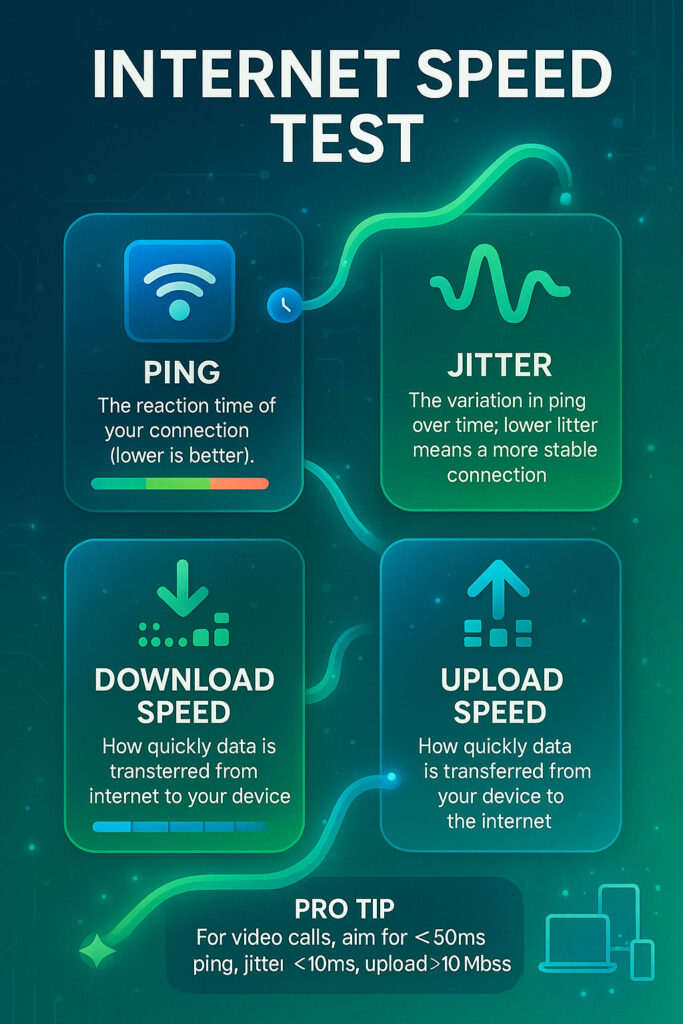Key Takeaways
- Speed tests measure your download speed, upload speed, ping, and jitter, giving you a quick snapshot of your internet performance and helping you identify any issues.
- For most households, download speeds of 100-250 Mbps and upload speeds of 20+ Mbps are ideal for streaming, video calls, and general browsing, while low ping (under 50 ms) ensures smooth gaming and conferencing.
- If your speeds are slower than expected, try moving closer to your router, reducing the number of devices using the network, or restarting your modem and router to improve performance.
Running an internet speed test is a quick and easy way to check how well your connection is performing. It can give you valuable insights into your connection’s performance. Whether you’re streaming your favorite show, gaming online, or working from home, knowing your download and upload speeds, ping, and jitter can help you troubleshoot issues or decide if it’s time to upgrade your internet plan. But once you see the results, it can be tricky to know what those numbers mean.
In this guide, we’ll break down what an internet speed test is, explain the key metrics like download speed, upload speed, ping, jitter, and latency, and help you understand what’s considered a good result. Plus, we’ll go over how each number can affect common activities like streaming, gaming, and video calls. Finally, we’ll explore some common reasons why your internet might be slower than expected.
What Is an Internet Speed Test?
An internet speed test measures how fast your connection can send and receive data between your device and a remote server. In simple terms, it checks how quickly your internet “talks” to the rest of the web.
When you start a speed test, your device connects to a nearby test server chosen automatically (or sometimes manually). The test then measures several things:
- Download speed: how fast data is pulled from the internet to your device.
- Upload speed: how quickly data travels from your device to the internet.
- Ping (latency): how long it takes for a tiny piece of data to make a round trip to the server and back.
- Jitter: how consistent those response times are during the test.
Here’s how it works behind the scenes: the testing tool sends packets of data back and forth between your device and the server for several seconds. It calculates your speeds based on how much data is transferred and how long it takes to complete each transfer. To give you the most accurate results, most tools automatically choose the closest or least congested server, minimizing outside factors that could slow things down.
Running a speed test is easy, you can visit popular tools like Speedtest.net or use your internet provider’s built-in tester. Within about 30 seconds, you’ll get a detailed snapshot of your internet’s performance, showing whether your speeds are living up to your plan and if your connection is healthy enough for streaming, gaming, or working from home.
Compare Internet Providers In Your Area
Understanding Your Speed Test Results

Here’s what each result means, why it’s important, and how it can affect your internet experience.
Download Speed
Download speed measures how quickly you can receive data from the internet, typically shown in megabits per second (Mbps). A fast download speed ensures smooth streaming, fast loading of websites, and quicker downloads of files. It’s especially important for watching videos in high definition, downloading large files, or browsing image-heavy sites.
- What is a Good Result:
- 100-250 Mbps: Great for browsing, HD streaming, and video calls.
- 250+ Mbps: Ideal for 4K streaming, large downloads, and multiple users.
Read More About What a Good Internet Speed is
- Impact on Activities:
- Streaming: Slow download speeds lead to buffering or lower video quality.
- Gaming: While download speed isn’t as critical for gameplay, it affects how quickly game updates or downloads are completed.
- Video Calls: High download speeds ensure a clear, uninterrupted video stream from others.
Upload Speed
Upload speed measures how quickly you can send data from your device to the internet. A good upload speed is essential for video calls, online gaming, live streaming, and uploading files to cloud storage. If your upload speed is too low, others may see a blurry video of you on a call, or your files may take a long time to upload.
- What is a Good Result:
- 10-20 Mbps: Suitable for occasional video calls and file uploads.
- 20+ Mbps: Great for remote work, video conferencing, and content creation.
- Impact on Activities:
- Video Calls: Low upload speeds can result in pixelated or frozen video, especially in group calls.
- Gaming: Slow uploads can cause lag, making your character respond slowly in online games.
- File Uploads: Large files will take longer to upload to email, cloud storage, or social media.
Ping (Latency)
Ping measures the time it takes for data to travel to a server and back, shown in milliseconds (ms). Lower ping means a faster response time. A low ping is crucial for real-time activities like gaming, video conferencing, and live streaming. High ping results in lag and delays, making interactions frustrating.
- Analyzing Your Result:
- Under 20 ms: Excellent for gaming and video calls.
- 20-50 ms: Suitable for most online activities.
- Over 100 ms: You may experience noticeable delays.
- Impact on Activities:
- Gaming: High ping causes noticeable lag, making it harder to compete in fast-paced games.
- Video Calls: Delays between voices and video can make conversations awkward.
- Streaming: While ping doesn’t affect watching videos, it can impact live streams.
Jitter
Jitter measures the variation in latency over time. It’s also displayed in milliseconds (ms) and reflects how stable your connection is. High jitter means inconsistent performance, resulting in choppy audio, laggy video calls, and unstable gaming sessions. A connection with low jitter ensures smoother performance, especially for real-time communication.
- Analyzing Your Result:
- Under 30 ms: Stable and reliable.
- Over 30 ms: May lead to audio or video disruptions.
- Impact on Activities:
- Video Calls: High jitter can cause distorted audio and frequent call drops.
- Gaming: You might experience unpredictable lag spikes.
- Streaming: While not as noticeable during regular streaming, live broadcasting can suffer from jitter.
How Your Connection Type Affects Speed Test Results
Not all internet connections are created equal, and the type of connection you use can have a big impact on your speed test results. Different technologies deliver data in different ways, which affects your speeds, stability, and even latency.
1. Fiber Internet
Fiber connections use light pulses sent through glass cables, allowing for extremely fast and reliable data transfer.
- Typical Results: High download and upload speeds (often symmetrical), low latency, and minimal jitter.
- What It Means for You: Fiber is the gold standard, perfect for streaming in 4K, gaming, working remotely, and supporting multiple users at once.
2. Cable Internet
Cable internet uses the same coaxial cables as traditional TV service. It’s widely available and typically offers fast download speeds but slower uploads.
- Typical Results: High download speeds, moderate upload speeds, and slightly higher latency during peak hours.
- What It Means for You: Great for streaming and browsing, but upload-heavy activities like live streaming or large file transfers may be slower.
3. DSL (Digital Subscriber Line)
DSL connects through standard phone lines. It’s slower than fiber or cable but still reliable for basic internet use.
- Typical Results: Lower download and upload speeds with moderate latency.
- What It Means for You: Fine for browsing and checking email, but may struggle with HD streaming or multiple users.
4. 5G and 4G LTE Home Internet
5G home internet relies on wireless signals from nearby towers. Performance depends heavily on signal strength and network congestion.
- Typical Results: Can range from very fast (comparable to cable) to inconsistent during busy times.
- What It Means for You: Convenient for areas without wired connections, but speeds can fluctuate based on location and signal quality.
5. Satellite Internet
Satellite connections use signals from orbiting satellites, which travel much farther than wired or wireless signals.
- Typical Results: Slower download speeds, higher latency, and potential for weather-related disruptions.
- What It Means for You: Suitable for rural areas where no other options exist, but latency can make video calls and gaming frustrating.
6. Wi-Fi vs. Wired (Ethernet)
Even your local connection type matters. A wired Ethernet connection is typically faster and more stable than Wi-Fi because it’s not affected by signal interference or distance.
- Wi-Fi: Convenient but can fluctuate depending on where you are in your home.
- Ethernet: Best for accurate speed tests and real-time activities like gaming or streaming in 4K.
Why Is My Internet Slow?
If your speed test results are lower than expected, here are some common reasons why:
- Too Many Devices: If multiple people in your home are streaming, gaming, or downloading files at once, your connection can slow down.
- Wi-Fi Interference: Walls, appliances, and other electronic devices can weaken your Wi-Fi signal. Moving closer to your router can help.
- Outdated Equipment: Older routers and modems may not support modern internet speeds. Upgrading your equipment can often improve performance.
- Network Congestion: Internet speeds may slow down during peak usage hours, usually in the evening when many people are online.
- ISP Limitations: Your internet service provider (ISP) may throttle speeds if you exceed your data limit or during times of heavy network traffic.
FAQs About Internet Speed Tests
How often should I run an internet speed test?
– When experiencing connectivity issues like buffering, lag, or dropped video calls.
– After changing your internet plan or provider to ensure you’re getting the promised speeds.
– Before important activities like gaming or video conferencing to check for stability.
What can I do to improve my internet speed?
– Move closer to your router or connect via Ethernet for a more stable connection.
– Restart your modem and router to clear temporary issues.
– Limit the number of devices using the network at once.
– Upgrade your internet plan if your household has high usage needs.
– Check for software updates on your router to ensure it’s running efficiently.
What is a good internet speed?
100-250 Mbps is great for general browsing, HD streaming, and video calls.
250+ Mbps is ideal for 4K streaming, large file downloads, and multiple users.
Upload speeds of 20+ Mbps work well for video conferencing and uploading large files.
Ping under 20 ms is excellent for gaming, while under 50 ms is good for most tasks.
How can I get the most accurate speed test result?
Close Applications: Stop any downloads, streaming, video calls, or cloud backups on all devices connected to your network.
Restart Your Modem/Router: A simple reboot can clear up temporary issues.
Choose a Close Server: Most tests automatically pick a server, but you can often manually select one from your ISP or a nearby city.
Test Multiple Times: Run the test a few times at different times of day to get an average.
Why do I get different results from different speed test services?
Why is my upload speed so much slower than my download speed?
Is it normal for my ping to be high?
Fiber: Typically has a very low ping (5-20ms).
Cable: Low to moderate ping (10-50ms).
DSL: Moderate ping (20-80ms).
Satellite: Very high ping (500ms+), making real-time activities difficult.
If your ping is suddenly much higher than usual, it could indicate a problem.
About the Author
David has been an integral part of some of the biggest utility sites on the internet, including InMyArea.com, HighSpeedInternet.com, BroadbandNow.com, and U.S. News. He brings over 15 years of experience writing about, compiling and analyzing utility data.
